Marrying Vega and Zen: The AMD Ryzen 5 2400G Review
by Ian Cutress on February 12, 2018 9:00 AM ESTBenchmarking Performance: CPU Office Tests
The office programs we use for benchmarking aren't specific programs per-se, but industry standard tests that hold weight with professionals. The goal of these tests is to use an array of software and techniques that a typical office user might encounter, such as video conferencing, document editing, architectural modelling, and so on and so forth.
All of our benchmark results can also be found in our benchmark engine, Bench.
Chromium Compile (v56)
Our new compilation test uses Windows 10 Pro, VS Community 2015.3 with the Win10 SDK to combile a nightly build of Chromium. We've fixed the test for a build in late March 2017, and we run a fresh full compile in our test. Compilation is the typical example given of a variable threaded workload - some of the compile and linking is linear, whereas other parts are multithreaded.
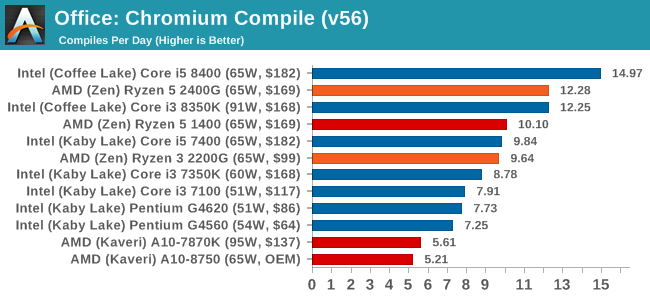
Our compile test has an eclectic mix of requirements, with different segments having different bottlenecks. The Ryzen 5 2400G matches the higher frequency of the Core i3-8350K, even though it already has a core and memory advantage. An interesting thing here is that the Ryzen 3 2200G and the Ryzen 5 1400 are almost evenly matched, even though the 1400 has double the threads. This is because of the frequency of the 2200G, and the memory speed.
PCMark 10
PCMark 10 is the latest all-in-one office-related performance tool that combines a number of tests for low-to-mid office workloads, including some gaming, but focusing on aspects like document manipulation, response, and video conferencing.

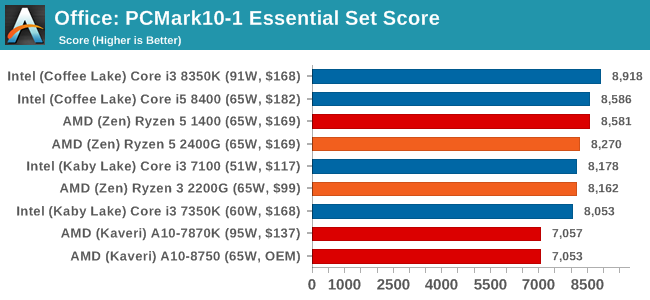
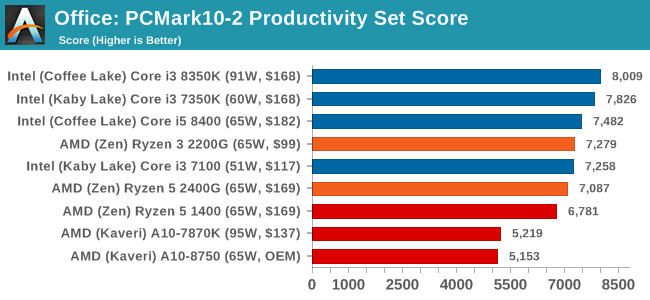
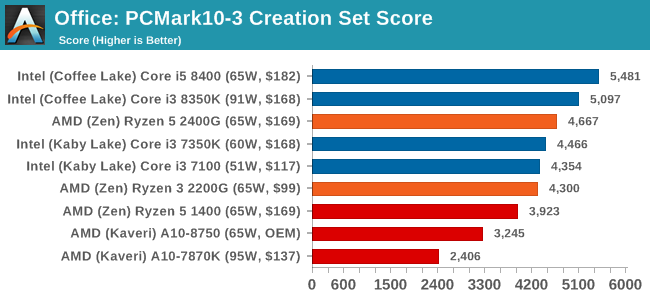
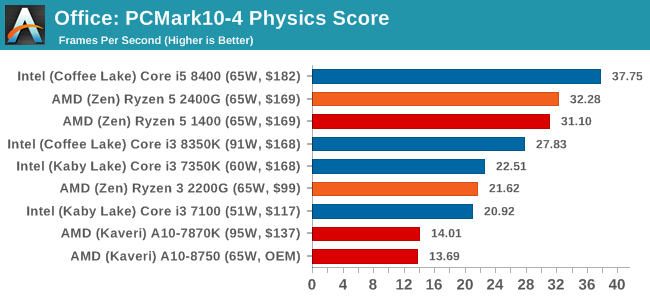
PCMark8: link
Despite originally coming out in 2008/2009, Futuremark has maintained PCMark8 to remain relevant in 2017. On the scale of complicated tasks, PCMark focuses more on the low-to-mid range of professional workloads, making it a good indicator for what people consider 'office' work. We run the benchmark from the commandline in 'conventional' mode, meaning C++ over OpenCL, to remove the graphics card from the equation and focus purely on the CPU. PCMark8 offers Home, Work and Creative workloads, with some software tests shared and others unique to each benchmark set.
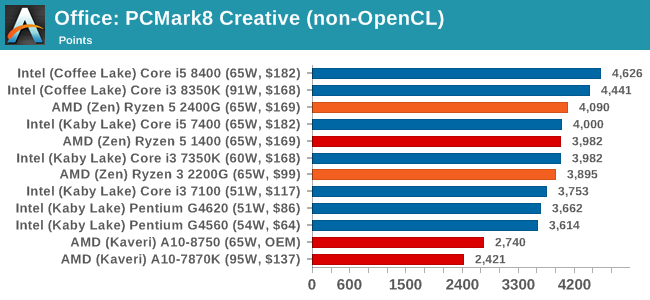
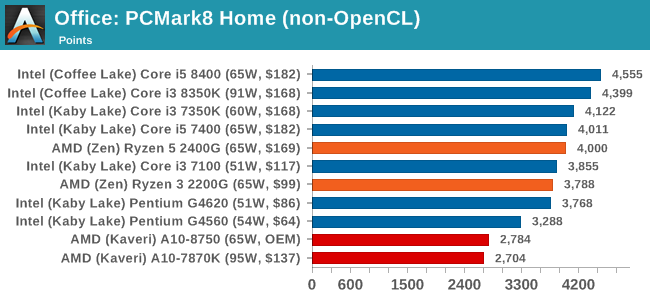
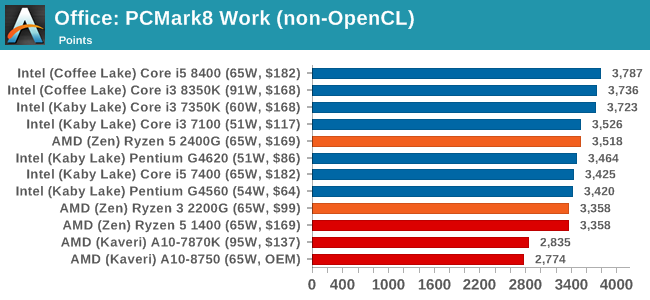










177 Comments
View All Comments
Gonemad - Wednesday, February 14, 2018 - link
These chips will cause a major segment of low-end graphics cards to be buried, or have their prices cut down. I can't wait for the benchmarks, and see how many generations will be affected.callmesissi - Wednesday, February 14, 2018 - link
what an amazing apu... this makes all celerons / pentiums and half of i3 completely out of market! this apu is so good, so cheap, kills all the entry level gpus and basically all those intel cpus mentioned .way to go amd! now about those drivers and bios....
edlee - Thursday, February 15, 2018 - link
this is amazing by AMD, they need to keep the hits coming, and chipping away market share from intel. Intel has not made any progress on processor graphics in years, this is a super aggressive strategy by AMD that i think will work. Nvidia basically has to cancel out any gpu line below gtx 1030 by next year. Hopefully AMD comes out with a GTX 1050 killer by next year.CSMR - Wednesday, February 14, 2018 - link
I think the relevant Intel comparisons would be processors with Iris Pro or Iris Plus.Hixbot - Wednesday, February 14, 2018 - link
Do these APUs not compete directly with the new Intel-Vega chips? Why did AMD give Intel Vega, when AMD could have had the APU market all to themselves?SaturnusDK - Wednesday, February 14, 2018 - link
Not really. The i8809G as it's called is supposedly a mobile part if you can call a 100W TDP part mobile by any stretch of the imagination. It's based on a 22 (or 24) CU Vega and will be much much more expensive. Expect it to land somewhere in the $400+ range, ie. more expensive than an 8700Kfranco1961 - Thursday, February 15, 2018 - link
Hi Ian. Two questions: I have to do a cheap PC for video editing (Adobe Premiere, After Effcets, etc.) and I thought about a Ryzen 3 1200 and a Geforce GT 1030. You think this Ryzen 5 2400G goes for video editing by having a Vega 11? Another question: using DDR4 2400 would I have a strong performance drop or could it be okay? Thank you!rexian96 - Thursday, February 15, 2018 - link
A question for Ian or anyone who knows - Does 2400G not support HW encoding of H264/265 and just limited decoding? Or that Handbrake doesn't support it yet? Looking at the encoding score it would seem 8400 is miles ahead though the GPU in Ryzen is much stronger.csell - Friday, February 16, 2018 - link
Hi. Do you know the max videoram?Will it be possible to use Crossfire between the shared ram and a graphics card?
If crossfire will be limited to VEGA graphics card, will I hope AMD will introduce a cheap graphics card with just 8 or 11 Vega compute units and may be HDMI 2.0
SaturnusDK - Friday, February 16, 2018 - link
There will be no crossfire with dGPUs. It's no possible at all.